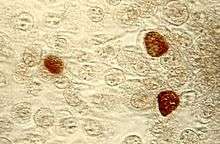Planctobacteria
| PVC group | |
|---|---|
 | |
| Chlamydia trachomatis | |
| Scientific classification (temporary) | |
| Domain: | Bacteria |
| Superphylum: | PVC group |
| Phyla | |
| Synonyms | |
|
Planctobacteria Cavalier-Smith, 1987[1] | |
Planctobacteria is a taxon created by Cavalier-Smith, specifically a division (phylum).[note 1] However, it is not followed by the larger scientific community.[2] Cavalier-Smith postulated that the Planctobacteria probably lost or reduced their peptidoglycan cell wall twice.[3]
In the Cavalier-Smith bacterial megaclassification, it is within the bacterial Gracilicutes infrakingdom and comprises the phyla Chlamydiae, Lentisphaerae, Planctomycetes, Verrucomicrobia.[3][4] It has been hypothesised that a member of the PVC clade might have been the host cell in the endosymbiotic event that gave rise to the first proto-eukaryotic cell.[5][6]
| PVC superphylum[7][8][9] | ||||||||||||||||||||||||||||||
| ||||||||||||||||||||||||||||||
Molecular signatures
These three groups in the traditional molecular phylogeny view are considered as phyla and also cluster together in what is referred to as the PVC superphylum, along with the candidate phyla OP3 and the Poribacteria.[10] An important molecular marker in the form of a conserved signature protein has been found to be consistently shared by PVC members, with the exception of Poribacteria. The conserved signature protein may be a marker that represents a synapomorphic quality and a means to distinguish this bacterial group. Recent studies have characterized this protein and it has been attributed to play an important housekeeping function in DNA/RNA binding.[11] This observation not only provides a means to demarcate the PVC superphylum, but it supports strongly supports an evolutionary relationship shared by this clade that is distinct from other bacteria.[12][13]
Conserved signature indels (CSIs)have also been found specific for the Planctomycetes, Verrucomicrobia, and Chlamydiae that distinguish each respective phylum from one another, and from other bacteria.[12][14] A three-amino-acid insert in the RNA polymerase protein RpoB has been found that is shared by all sequenced Verrucomicrobia, Chlamydiae, and Lentisphaerae species. The CSI is absent from neighbouring Planctomycetes' and Poribacteria, suggesting common ancestry among the groups for which the CSI is specific.[12]
Additional lines of evidence for the existence of this clade have been found.[15][16] These include the presence of membrane coat-like proteins, tubulin, sterol synthesis, and the presence of condensed DNA.
Notes
- ↑ Historically bacteria were considered plants consequently the usage of "division" over "phylum" was brought over when the kingdom Monera was established. The bacteriological code has since imposed that the rank should be phylum and not division. Nevertheless, Cavalier-Smith adopts the term division.
References
- ↑ Cavalier-Smith, T. (1987). The origin of eukaryote and archaebacterial cells. Annals of the New York Academy of Sciences 503, 17–54.
- ↑ Krieg, N.R.; Ludwig, W.; Whitman, W.B.; Hedlund, B.P.; Paster, B.J.; Staley, J.T.; Ward, N.; Brown, D.; Parte, A. (November 24, 2010) [1984(Williams & Wilkins)]. George M. Garrity, ed. The Bacteroidetes, Spirochaetes, Tenericutes (Mollicutes), Acidobacteria, Fibrobacteres, Fusobacteria, Dictyoglomi, Gemmatimonadetes, Lentisphaerae, Verrucomicrobia, Chlamydiae, and Planctomycetes. Bergey's Manual of Systematic Bacteriology. 4 (2nd ed.). New York: Springer. p. 908. ISBN 978-0-387-95042-6. British Library no. GBA561951.
- 1 2 Cavalier-Smith, T (2002). "The neomuran origin of archaebacteria, the negibacterial root of the universal tree and bacterial megaclassification". International Journal of Systematic and Evolutionary Microbiology. 52 (Pt 1): 7–76. doi:10.1099/00207713-52-1-7. PMID 11837318.
- ↑ Cavalier-Smith T (2006). "Rooting the tree of life by transition analyses". Biol. Direct. 1 (1): 19. doi:10.1186/1745-6150-1-19. PMC 1586193
 . PMID 16834776.
. PMID 16834776. - ↑ Forterre, Patrick (January 2011). "A new fusion hypothesis for the origin of Eukarya: better than previous ones, but probably also wrong". Research in Microbiology. 162 (1): 77–91. doi:10.1016/j.resmic.2010.10.005.
- ↑ Baum, David A; Baum, Buzz (28 October 2014). "An inside-out origin for the eukaryotic cell". BMC Biology. 12 (1). doi:10.1186/s12915-014-0076-2.
- ↑ Rappe, M. S.; Giovannoni, S. J. (2003). "The Uncultured Microbial Majority". Annual Review of Microbiology. 57: 369–394. doi:10.1146/annurev.micro.57.030502.090759. PMID 14527284.
- ↑ Woese, C. R. (1987). "Bacterial evolution". Microbiological reviews. 51 (2): 221–271. PMC 373105
 . PMID 2439888.
. PMID 2439888. - ↑ Wagner, M.; Horn, M. (2006). "The Planctomycetes, Verrucomicrobia, Chlamydiae and sister phyla comprise a superphylum with biotechnological and medical relevance". Current Opinion in Biotechnology. 17 (3): 241–249. doi:10.1016/j.copbio.2006.05.005. PMID 16704931.
- ↑ Wagner, M.; Horn, M. (2006). "The Planctomycetes, Verrucomicrobia, Chlamydiae and sister phyla comprise a superphylum with biotechnological and medical relevance". Current Opinion in Biotechnology. 17 (3): 241–249. doi:10.1016/j.copbio.2006.05.005. PMID 16704931.
- ↑ Lagkouvardos I, Jehl MA, Rattei T, Horn M (2014). "Signature protein of the PVC superphylum". Appl Environ Microbiol. 80 (2): 440–445. doi:10.1128/AEM.02655-13. PMID 24185849.
- 1 2 3 Gupta RS, Bhandari V, Naushad HS (2012). "Molecular Signatures for the PVC Clade (Planctomycetes, Verrucomicrobia, Chlamydiae, and Lentisphaerae) of Bacteria Provide Insights into Their Evolutionary Relationships". Front Microbiol. 3: 327. doi:10.3389/fmicb.2012.00327. PMC 3444138
 . PMID 23060863.
. PMID 23060863. - ↑ Gupta RS (2016). "Impact of genomics on the understanding of microbial evolution and classification: the importance of Darwin's views on classification". FEMS Microbiol Rev. 40 (4): 520–53. doi:10.1093/femsre/fuw011. PMID 27279642.
- ↑ Gupta RS, Naushad S, Chokshi C, Griffiths E, Adeolu M (2015). "A phylogenomic and molecular markers based analysis of the phylum Chlamydiae: proposal to divide the class Chlamydiia into two orders, Chlamydiales and Parachlamydiales ord. nov., and emended description of the class Chlamydiia". Antonie Van Leeuwenhoek. 108 (3): 765–781. doi:10.1007/s10482-015-0532-1. PMID 26179278.
- ↑ Wagner M, Horn M (2006). "The Planctomycetes, Verrucomicrobia, Chlamydiae and sister phyla comprise a superphylum with biotechnological and medical relevance". Curr. Opin. Biotechnol. 17 (3): 241–9. doi:10.1016/j.copbio.2006.05.005. PMID 16704931.
- ↑ Kamneva OK, Liberles DA, Ward NL (2010). "Genome-wide influence of indel Substitutions on evolution of bacteria of the PVC superphylum, revealed using a novel computational method". Genome Biol Evol. 2: 870–86. doi:10.1093/gbe/evq071. PMC 3000692
 . PMID 21048002.
. PMID 21048002.